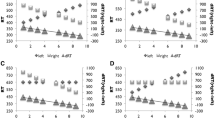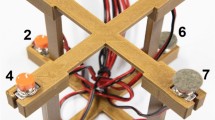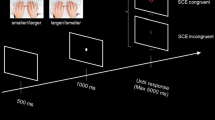Abstract
The aim of the present paper is to provide an overview of the evidence that links spatial representation with representation of number magnitude. This aim is achieved by reviewing the literature concerning the number interval bisection task in patients with left hemispatial neglect and in healthy participants (pseudoneglect). Phenomena like the Spatial Numerical Association of Response Codes (SNARC) effect and the shifts of covert spatial attention caused by number processing are thought to support the notion that number magnitude is represented along a spatially organized mental number line. However, the evidence provided by chronometric studies is not univocal and is open to alternative, non-spatial interpretations. In contrast, neuropsychological studies have offered convincing evidence that humans indeed represent numbers on a mental number line oriented from left to right. Neglect patients systematically misplace the midpoint of a numerical interval they are asked to bisect (e.g., they say that 〈5〉 is halfway between 〈2〉 and 〈6〉) and their mistakes closely resemble the typical pattern found in bisection of true visual lines. The presence of dissociations between impaired explicit knowledge and spared implicit knowledge supports the notion that neglect produces a deficit in accessing an intact mental number line, rather than a distortion in the representation of that line. Other results show that the existence of a strong spatial connotation constitutes a specific property of number representations rather than a general characteristic of all ordered sequences.
Similar content being viewed by others
Notes
Zorzi et al.’s (2002) neglect patients were unimpaired in arithmetical tasks, which, at first sight, seems to contradict the notion that quantity is represented spatially. However, Priftis et al. (2006) have subsequently shown that in neglect patients, spatial representations of numbers are intact and only explicit access to those spatial representations is impaired. In addition, it should be kept in mind that Zorzi et al.’s neglect patients were perfectly able to bisect the number interval by applying an algorithm, that is, through the use of Dehaene’s (1992) verbal code (see above). However, they were strictly asked not to do so.
Alternatively, one may think that smaller numbers are cognitively more available, perhaps because of their higher frequency. However, this interpretation is contradicted by the observation that the effect is modulated by head rotation (Loetscher et al. 2008): Participants showed a bias towards producing smaller numbers when their head (along with their spatial attention, presumably) was rotated to the left, whereas they produced larger numbers when their head was rotated to the right.
References
Anderson B (1993) Spared awareness for the left side of internal visual images in patients with left-sided extrapersonal neglect. Neurology 1:213–216
Arduino LS, Burani C, Vallar G (2003) Reading aloud and lexical decision in neglect patients: a dissociation. Neuropsychologia 41:877–885
Berti A (2002) Unconscious processing in neglect. In: Karnath HO, Milner AD, Vallar G (eds) The cognitive and neural bases of spatial neglect. Oxford University Press, Oxford, pp 313–326
Berti A, Rizzolatti G (1992) Visual processing without awareness: evidence from unilateral neglect. J Cogn Neurosci 4:345–351
Bisiach E, Luzzatti C (1978) Unilateral neglect of representational space. Cortex 14:129–133
Bisiach E, Rusconi ML, Peretti VA, Vallar G (1994) Challenging current accounts of unilateral neglect. Neuropsychologia 11:1431–1434
Bonato M, Priftis K, Marenzi R, Zorzi M (2008a) Modulation of hemispatial neglect by directional and numerical cues in the line bisection task. Neuropsychologia 46:423–433
Bonato M, Priftis K, Marenzi R, Zorzi M (2008b) Normal and impaired orienting of attention following central non-predictive cues. J Cogn Neurosci (in press)
Bowers D, Heilman KM (1980) Pseudoneglect: effects of hemispace on a tactile line bisection task. Neuropsychologia 18:491–498
Cappelletti M, Freeman ED, Cipolotti L (2007) The middle house or the middle floor: bisecting horizontal and vertical mental number lines in neglect. Neuropsychologia 45:2989–3000
Casarotti M, Michielin M, Zorzi M, Umiltà C (2007) Temporal order judgment reveals how number magnitude affects visuospatial attention. Cognition 102:101–117
Cavézian C, Rossetti Y, Danckert J, d’Amato T, Dalery J, Saoud M (2007) Exaggerated leftward bias in the mental number line of patients with schizophrenia. Brain Cogn 63:85–90
Chokron S, Bernard JM, Michel I (1997) Length representation in normal and neglect subjects with opposite reading habits studied through a line extension task. Cortex 35:47–64
Dehaene S (1992) Varieties of numerical abilities. Cognition 44:1–42
Dehaene S (2003) The neural basis of the Weber–Fechner law: a logarithmic mental number line. Trends Cogn Sci 7:145–147
Dehaene S, Dupoux E, Mehler J (1990) Is numerical comparison digital? Analogical and symbolic effects in two-digit number comparison. J Exp Psychol Hum Percept Perform 16:626–641
Dehaene S, Bossini S, Giraux P (1993) The mental representation of parity and number magnitude. J Exp Psychol Gen 122:371–396
Dehaene S, Piazza M, Pinel P, Cohen L (2003) Three parietal circuits for number processing. Cogn Neuropsychol 20:487–506
Dodd MD, Stigchel SV, Adil Leghari M, Fung G, Kingstone A (2008) Attentional SNARC: there’s something special about numbers (let us count the ways). Cognition 108:810–818
Doricchi F, Guariglia P, Gasparini M, Tomaiuolo F (2005) Dissociation between physical and mental number line bisection in right hemisphere brain damage. Nat Neurosci 8:1663–1666
Farnè A, Rossetti Y, Toniolo S, Làdavas E (2002) Ameliorating neglect with prism adaptation: Visuo-manual and visuo-verbal measures. Neuropsychologia 40:718–729
Fias W, Brysbaert M, Geypens F, d’Ydewalle G (1996) The importance of magnitude information in numerical processing: Evidence from the SNARC effect. Mathem Cogn 2:95–110
Fischer MH (2001) Number processing induces spatial performance bias. Neurology 57:822–826
Fischer MH (2003) Spatial representations in number processing: evidence from a pointing task. Vis Cogn 10:493–508
Fischer MH, Castel AD, Dodd MD, Pratt J (2003) Perceiving numbers causes spatial shifts of attention. Nat Neurosci 6:555–556
Fischer MH, Warlop N, Hill RL, Fias W (2004) Oculomotor bias induced by number perception. Exp Psychol 51:91–97
Galfano G, Rusconi E, Umiltà C (2006) Number magnitude orients attention, but not against one’s will. Psychon Bull Rev 13:869–874
Gallistel CR, Gelman R (2000) Non-verbal numerical cognition: from reals to integers. Trends Cogn Sci 4:59–65
Galton F (1880) Visualised numerals. Nature 21:252–256
Gevers W, Ratinckx E, De Baene W, Fias W (2006a) Further evidence that the SNARC effect is processed along a dual-route architecture: evidence from the lateralized readiness potential. Exp Psychol 53:58–68
Gevers W, Verguts T, Reynvoet B, Caessens B, Fias W (2006b) Numbers and space: a computational model of the SNARC effect. J Exp Psychol Hum Percept Perform 32:32–34
Goebel S, Calabria M, Farnè A, Rossetti Y (2006) Parietal rTMS distorts the mental number line: simulating ‘spatial’ neglect in healthy subjects. Neuropsychologia 44:860–868
Guariglia C, Padovani AP, Pantano O, Pizzamiglio L (1993) Unilateral neglect restricted to visual imagery. Nature 364:235–237
Halligan PW, Marshall JC (1988) How long is a piece of string? A study of line bisection in a case of visual neglect. Cortex 24:321–328
Halligan PW, Fink GR, Marshall JC, Vallar G (2003) Spatial cognition: evidence from visual neglect. Trends Cogn Sci 3:125–133
Heilman KM, Watson RT, Valenstein E (1979) Neglect and related disorders. In: Heilman KM, Valenstein E (eds) Clinical neuropsychology. Oxford University Press, New York, pp 268–307
de Hevia MD, Girelli L, Vallar G (2006) Number and space: a cognitive illusion? Exp Brain Res 168:254–264
Hoeckner SH, Zauner H, Moeller K, Wood G, Haider C, Gaßner A, Nuerk HC (2008) Impairments of the mental number line for two-digit numbers in neglect. Cortex 44:429–438
Holyoak KJ (1977) The form of analog size information in memory. Cog Psych 9:31–51
Hubbard EM, Piazza M, Pinel P, Dehaene S (2005) Interactions between number and space in parietal cortex. Nat Rev Neurosci 6:435–448
Jewell G, McCourt ME (2000) Pseudoneglect: a review and meta-analysis of performance factors in line bisection tasks. Neuropsychologia 38:93–110
Keus IM, Schwarz W (2005) Searching for the functional locus of the SNARC effect: evidence for a response related origin. Mem Cognit 33:681–695
Keus IM, Jenks KM, Schwarz W (2005) Psychophysiological evidence that the SNARC effect has its functional locus in a response selection stage. Cogn Brain Res 24:48–56
Kosslyn SM, Murphy GL, Bamesderfer ME, Feinstein KJ (1977) Category and continuum in mental comparisons. J Exp Psych Gen 106:341–375
Làdavas E, Petronio A, Umiltà C (1990) The deployment of visual attention in the intact field of hemineglect patients. Cortex 26:307–317
Làdavas E, Paladini R, Cubelli R (1993) Implicit associative priming in a patient with left visual neglect. Neuropsychologia 12:1307–1320
Làdavas E, Umiltà C, Mapelli D (1997) Lexical and semantic processing in the absence of word reading: Evidence from neglect dyslexia. Neuropsychologia 35:1075–1085
Loetscher M, Brugger P (2007) Exploring number space by random digit generation. Exp Brain Res 180:655–665
Loetscher M, Schwarz U, Schubiger M, Brugger P (2008) Head turns bias the brain’s internal random generator. Curr Biol 18:R60–R62
Loftus AM, Nicholls ME, Mattingley JB, Bradshaw JL (2007) Left to right: representational biases for numbers and the effect of visuomotor adaptation. Cognition 107:1048–1058
Loftus AM, Nicholls ME, Mattingley JB, Chapman HL, Bradshaw JL (2008) Pseudoneglect for the bisection of mental number lines. Q J Exp Psychol (in press)
Longo MR, Lourenco SF (2007) Spatial attention and the mental number line: evidence for characteristic biases and compression. Neuropsychologia 45:1400–1407
Lu CH, Proctor RW (1995) The influence of irrelevant location information on performance—a review of the Simon and spatial Stroop effects. Psychon Bull Rev 2:174–207
Marshall JC, Halligan PW (1988) Blindsight and insight in visuo-spatial neglect. Nature 336:766–767
Marshall JC, Halligan PW (1989) When right goes left: an investigation of line bisection in a case of visual neglect. Cortex 25:503–515
Michel C, Cavezian C, d’Amato T, Dalery J, Rode G, Saoud M, Rossetti Y (2007) Pseudoneglect in schizophrenia: a line bisection study with cueing. Cognit Neuropsychiatry 12:222–234
Moyer RS, Landauer TK (1967) The time required for judgements of numerical inequality. Nature 215:1519–1520
Nicholls ME, Loftus AM (2007) Pseudoneglect and neglect for mental alphabet lines. Brain Res 1152:130–138
Nicholls ME, Kamer A, Loftus AM (2008) Pseudoneglect for mental alphabet lines is affected by prismatic adaptation. Exp Brain Res 191:109–115
Pia L, Corazzino LL, Folegatti A, Gindri P, Cauda F (2008) Mental number line disruption in a right-neglect patient after left-hemisphere stroke. Brain Cogn (in press)
Priftis K, Zorzi M, Meneghello F, Marenzi R, Umiltà C (2006) Explicit versus implicit processing of representational space in neglect: dissociations in accessing the mental number line. J Cogn Neurosci 18:680–688
Priftis K, Piccione F, Giorgi F, Meneghello F, Umiltà C, Zorzi M (2008) Lost in number space after right brain damage: a neural signature of representational neglect. Cortex 44:449–453
Proctor RW, Cho YS (2006) Polarity correspondence: a general principle for performance of speeded binary classification tasks. Psychol Bull 132:416–442
Restle F (1970) Speed of adding and comparing numbers. J Exp Psych 83:274–278
Ristic J, Wright A, Kingstone A (2006) The number line effect reflects top-down control. Psychon Bull Rev 113:862–868
Rode G, Rossetti Y, Boisson D (2001) Prism adaptation improves representational neglect. Neuropsychologia 39:1250–1254
Rossetti Y, Rode G, Pisella L, Farnè A, Li L, Boisson D, Perenin MT (1998) Prism adaptation to rightward optical deviation rehabilitates left hemispatial neglect. Nature 395:166–169
Rossetti Y, Jacquin-Courtois S, Rode G, Ota H, Michel C, Boisson D (2004) Does action make the link between number and space representation? Psychol Sci 15:426–430
Santens S, Gevers W (2008) The SNARC effect does not imply a mental number line. Cognition 108:263–270
Schwarz W, Keus IM (2004) Moving the eyes along the mental number line: comparing SNARC effects with saccadic and manual responses. Percept Psychophys 66:651–664
Schwarz W, Müller D (2006) Spatial associatiosn in number-related tasks: a comparison of manual and pedal responses. Exp Psychol 53:4–15
Stoianov I, Kramer P, Umiltà C, Zorzi M (2008) Visuospatial priming of the mental number line. Cognition 106:770–779
Vallar G, Guariglia C, Nico D, Tabossi P (1996) Left neglect dyslexia and the processing of neglected information. J Clin Exp Neuropsychol 18:733–746
Vuilleumier P, Ortigue S, Brugger P (2004) The number space and neglect. Cortex 40:399–410
Walsh V (2003) A theory of magnitude: common cortical metrics of time, space, and quantity. Trends Cogn Sci 7:483–488
Woocher FD, Glass AL, Holyoak KJ (1978) Positional discriminability in linear orderings. Mem Cognit 6:165–173
Zamarian L, Egger C, Delazer M (2007) The mental representation of ordered sequences in visual neglect. Cortex 43:542–550
Zorzi M, Umiltà C (1995) A computational model of the Simon effect. Psychol Res 58:193–205
Zorzi M, Priftis K, Umiltà C (2002) Neglect disrupts the mental number line. Nature 417:138–139
Zorzi M, Priftis K, Meneghello F, Marenzi R, Umiltà C (2004) Dissociations in the bisection of visual lines and number lines in neglect. Poster presented at the first congress of the European Neuropsychological Societies, Modena, Italy
Zorzi M, Priftis K, Meneghello F, Marenzi R, Umiltà C (2006) The spatial representation of numerical and non-numerical sequences: evidence from neglect. Neuropsychologia 44:1061–1067
Acknowledgments
Preparation of this paper was supported by grants from MIUR (Prin 2005 and Prin 2006) to CU and MZ and from CARIPARO Foundation to MZ and KP.
Author information
Authors and Affiliations
Corresponding author
Rights and permissions
About this article
Cite this article
Umiltà, C., Priftis, K. & Zorzi, M. The spatial representation of numbers: evidence from neglect and pseudoneglect. Exp Brain Res 192, 561–569 (2009). https://doi.org/10.1007/s00221-008-1623-2
Received:
Accepted:
Published:
Issue Date:
DOI: https://doi.org/10.1007/s00221-008-1623-2




